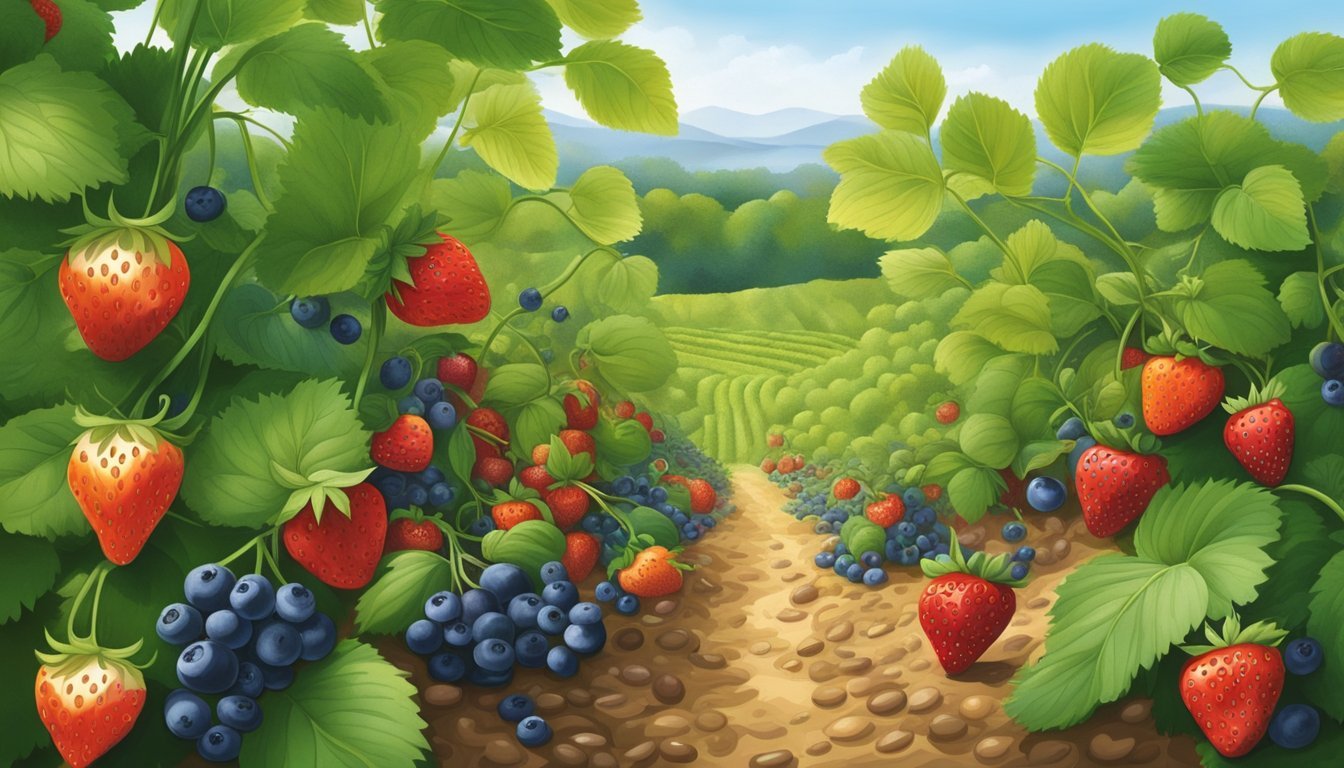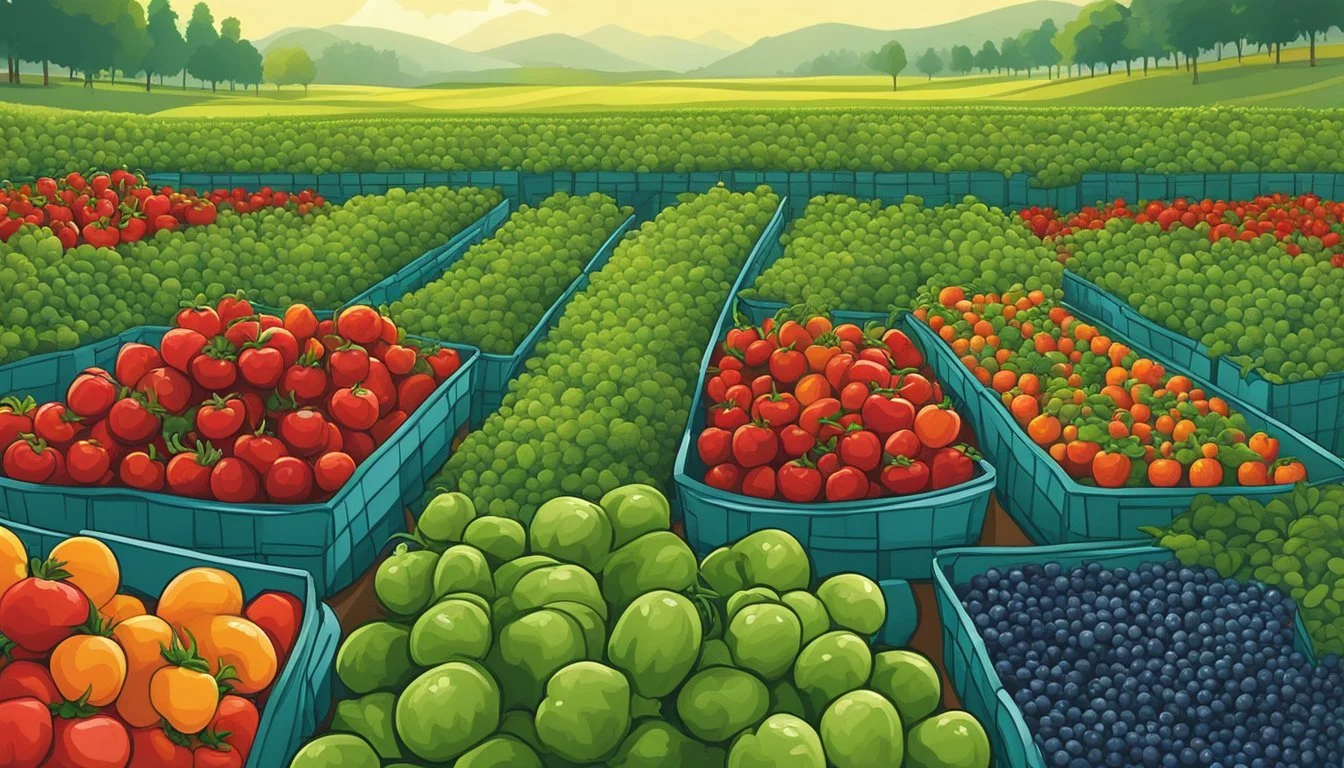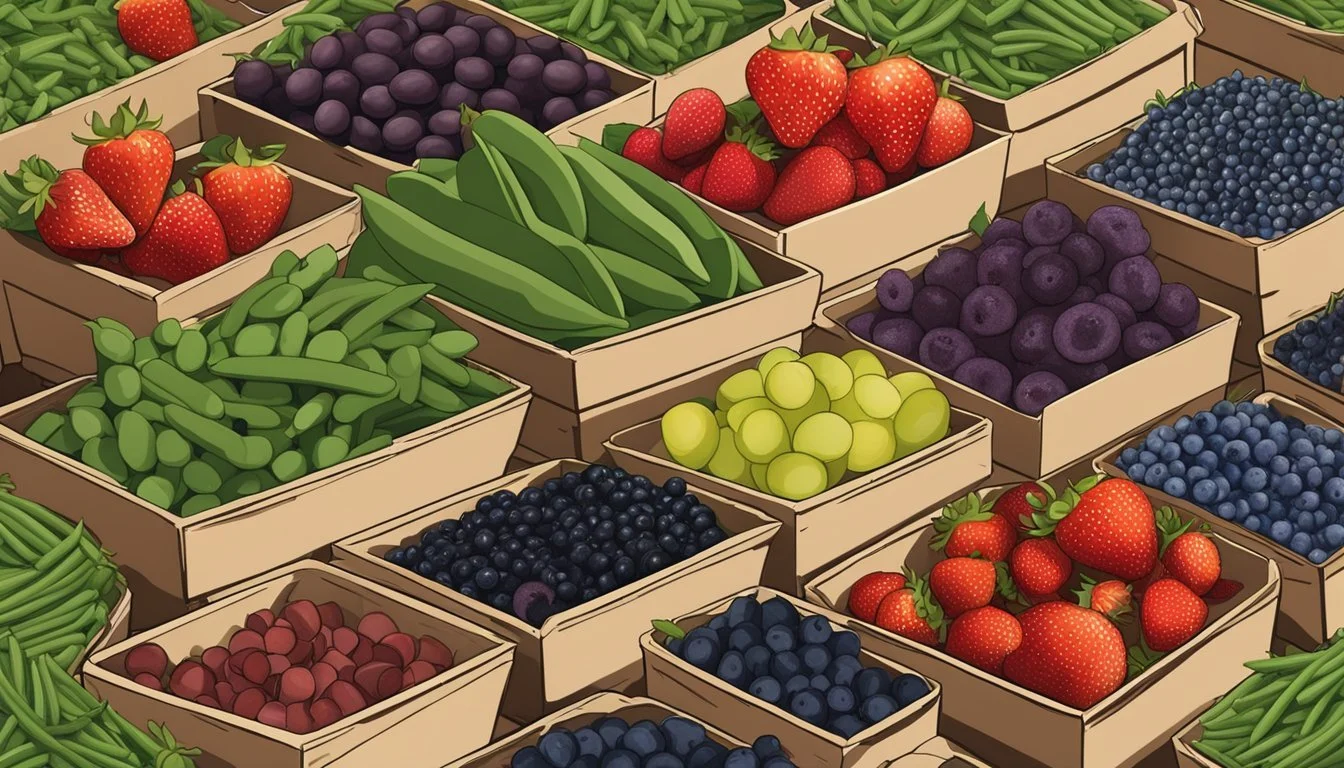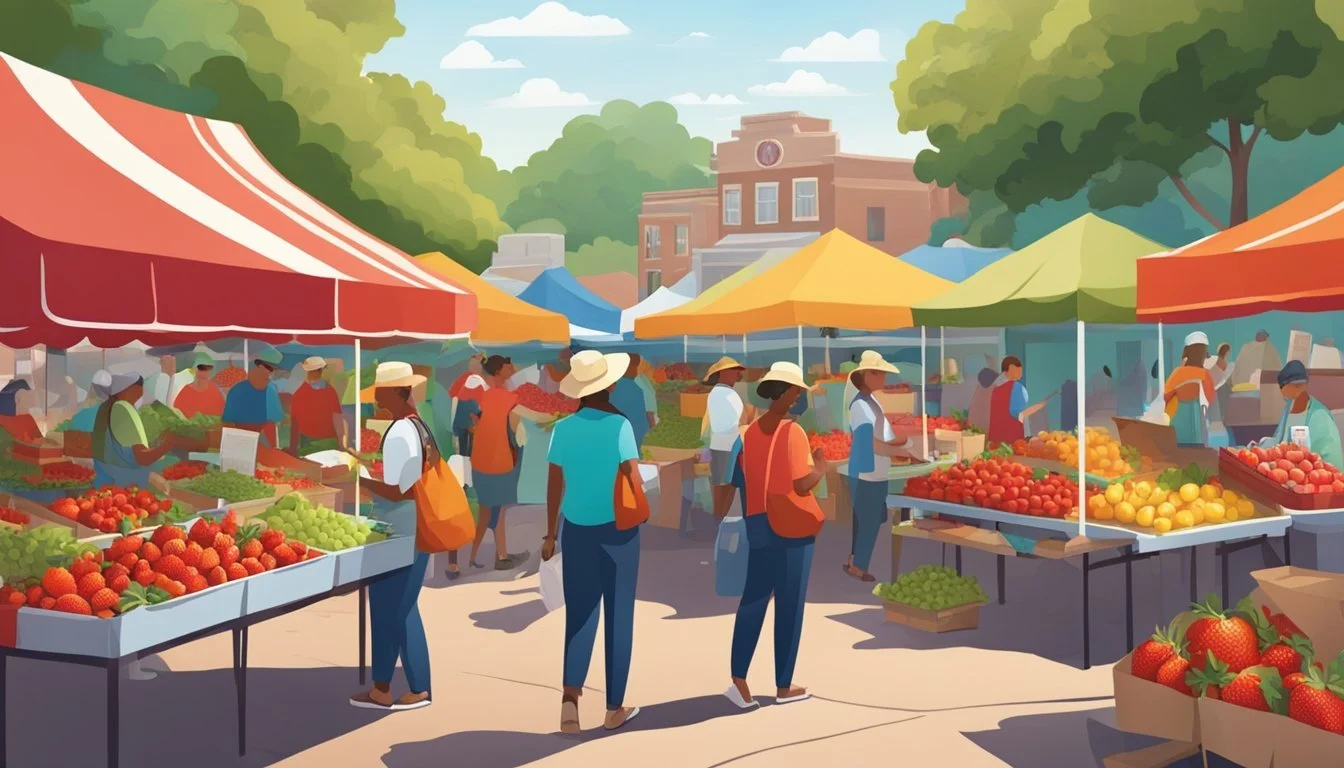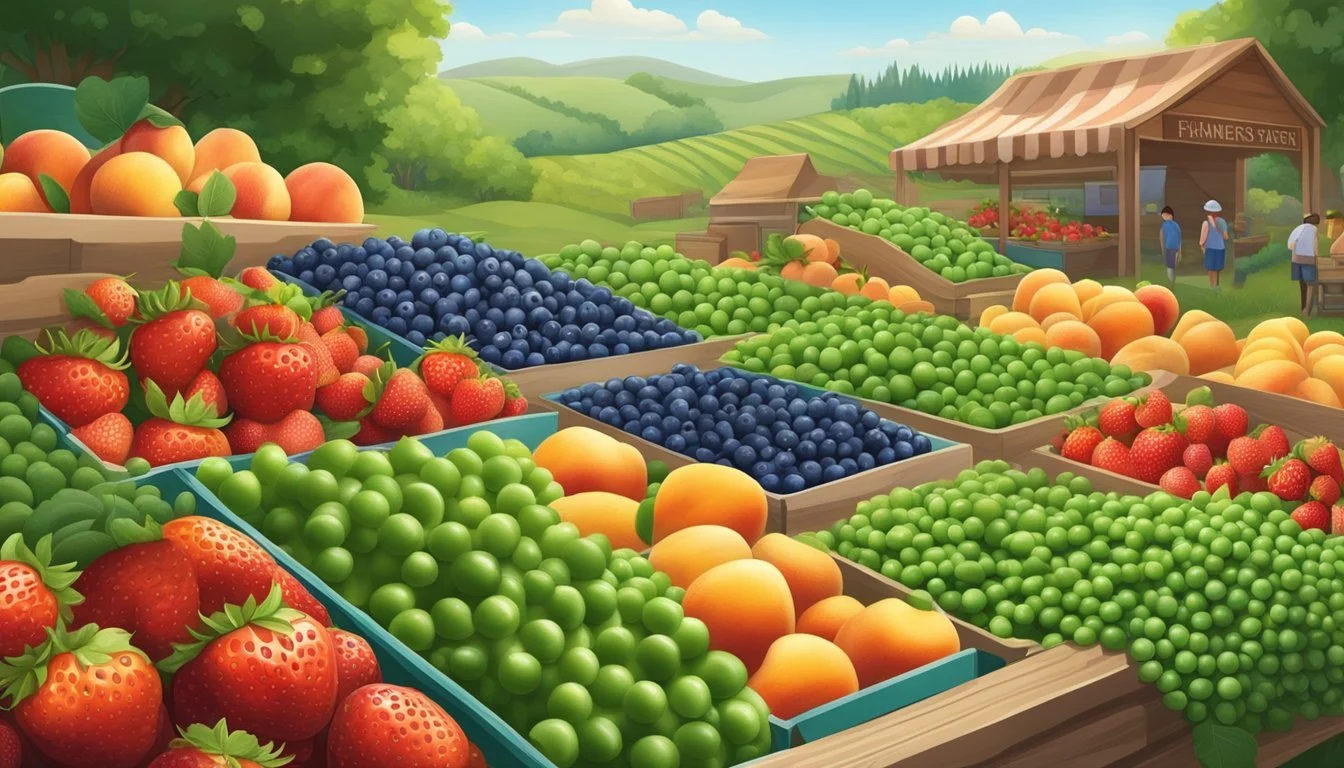Indiana Seasonal Fruit & Vegetables in June
Your Fresh Guide
This Article is Part of our Indiana Seasonal Fruit & Veg Calendar
Indiana's agricultural landscape bursts into a vibrant tableau of flavors and colors as June ushers in an array of seasonal fruits and vegetables. Farmers markets across the state become especially lively, showcasing the bounty that local farmers have nurtured. With warm days and mild nights, June provides the perfect climate for a variety of produce to thrive.
Seasonal fruits entering their peak during this month include juicy strawberries, which often herald the beginning of Indiana's fruit season. Tart cherries (how long do cherries last?) also reach maturity, providing a beloved staple for pies and preserves. As for vegetables, the soil yields nutritious greens like spinach and kale, and the first crisp cucumbers and sweet peas make their welcome appearance.
Shoppers at Indiana's farmers markets can relish the freshness that only locally sourced, in-season produce can offer. The transition from spring to summer brings new layers of flavor with homegrown zucchini, radishes, and beets enriching the culinary landscape. Eating seasonally in June not only supports local farmers but also ensures consumers are getting the most flavorful and nutritious produce available.
Indiana Fruit Availability in June
June in Indiana heralds the arrival of a variety of fresh fruits, especially sweet and juicy berries and tender stone fruits which begin to reach their peak ripeness during this month.
Berries
Strawberries: In June, strawberries are usually at their peak, offering sweet and plump berries perfect for picking. Blueberries: (how long do blueberries last?) Towards the end of June, blueberries begin to ripen, with availability increasing as the month progresses. Raspberries: Available in some areas, June might offer the first raspberries of the season, with their availability expected to peak later in the summer.
Stone Fruits
Cherries: Sweet cherries come into season in June, presenting an ideal opportunity for cherry picking. Peaches and Plums: Late June may see the start of the peach and plum season, with early varieties becoming ready to eat.
Additional June Fruits
Other fruits that might start to appear in markets in June can include:
Apples: Early varieties might be found, although the traditional apple season is later in the year.
Grapes: It’s typically early for local grapes, but initial varieties might be spotted by the end of the month.
Indiana Vegetable Availability in June
June offers a plentiful harvest of diverse vegetables in Indiana. With the summer season setting in, the produce available during this month is both vibrant and fresh, marking an ideal time for consumers to access a variety of vegetables.
Leafy Greens
One can find a bounty of leafy greens thriving in June. Lettuce, kale, and spinach are especially tender and flavorful during this early summer period. These greens are essential for salads and side dishes.
Lettuce
Kale
Spinach
Root Vegetables
June also sees the continuation of the root vegetable harvest. Radishes and carrots provide crunch and color to dishes, and they remain in their prime this month.
Radishes
Carrots
Squashes and Gourds
While it's early for most members of the squash family, zucchini often makes its first appearance in the gardens of Indiana during June. It's a versatile vegetable that can be grilled, sautéed, or baked.
Zucchini
Podded Vegetables
Podded vegetables such as peas and green beans start to mature in June, offering crisp textures and a sweetness that can only be achieved from freshly picked produce.
Peas
Green Beans
Nightshades
Nightshades like tomatoes and peppers begin to come into season. Although typically more robust by late summer, the early varieties can still be found at local markets and are ripe for the picking.
Tomatoes
Peppers
Benefits of Eating Seasonally
Eating seasonally carries several advantages, some of which include supporting local farmers, optimizing nutrition, and enjoying the freshness of produce. When consumers choose seasonal fruits and vegetables, they typically purchase crops harvested at their peak. This not only translates into a better taste because of freshness but also means that the produce usually has a higher content of nutrients compared to fruits and vegetables that are shipped over long distances.
Local Farmers: Local economies benefit when consumers buy seasonally. As shoppers opt for produce that is in season locally, they support area farmers who rely on their nearby communities. This support helps sustain agricultural diversity in the region and keeps local farms viable.
Seasonal Produce: Seasonal produce is often less expensive due to the abundance of the crop during its peak season. Additionally, it tends to be fresher, as it doesn't have to endure long shipping processes, which can degrade flavor and texture.
Nutrition: The nutritional content of fruits and vegetables begins to decline after harvest. Eating seasonally ensures that individuals consume produce closer to the time it was picked, maximized for vitamins and minerals. For instance, leafy greens might be richest in vitamin C and antioxidants when consumed during their natural growing season.
In June, Indiana's seasonal foods likely include a variety of fresh berries, summer squash, and sweet corn, providing consumers with delicious options that are also nutritionally beneficial. Choosing these seasonal foods not only supports individual health and local agricultural practices but also connects consumers to the natural cycles of the environment they live in.
Preparation and Preservation
Preparing and preserving the bounty of Indiana’s seasonal fruits and vegetables in June allows residents to enjoy their fresh flavors all year round. These methods ensure that nothing goes to waste and the local harvest can be savored even after the season ends.
Canning and Pickling
Canning is a method of preservation that involves placing fruits and vegetables in jars and heating them to a temperature that destroys microorganisms. Seasonal vegetables like cucumbers can be pickled, providing the crunch and tang of pickles throughout the year. Fruits such as strawberries and peaches, both of which are in season in June, are exceptional choices for canning because their natural sweetness intensifies in the process.
Sterilize canning jars and lids.
Prepare the fruit syrup or use water.
Pack fruit into jars and cover with syrup, leaving headspace.
Process in a water bath or pressure canner as recommended.
Freezing
Freezing is arguably the easiest method for preserving the harvest. Seasonal fruits like blueberries and raspberries freeze well, as do seasonal vegetables such as sweet corn and green beans. Ensure that the produce is clean, dry, and cut into preferred sizes before freezing them in airtight containers or bags.
Tips for optimal freezing:
Blanch vegetables before freezing to preserve color and texture.
Spread berries on a baking sheet to freeze individually before bagging.
Drying
Drying removes moisture from the produce, extending its shelf life and concentrating flavors. Herbs, as well as fruits like apples, can be dried easily. Indiana’s June seasonal fruits and vegetables provide excellent opportunities for creating dried snacks or ingredients for later use.
Helpful hints for drying fruits and vegetables:
Slice produce uniformly for even drying.
Use a dehydrator or a low-temperature oven for the best results.
Seasonal Recipes and Usage Ideas
In June, Indiana's markets brim with an abundance of fresh produce. This seasonal bounty lends itself to an array of delicious recipes, taking advantage of the freshest flavors.
Strawberry and Spinach Salad: A classic for a reason. Tender spinach leaves pair beautifully with sweet, ripe strawberries that are at their peak. A sprinkle of feta and a drizzle of balsamic vinaigrette elevate this simple salad.
For Berry Pies: Whether it's blueberries, strawberries, or raspberries, June is the perfect time to bake them into a pie. Their natural sweetness is enhanced in the heat of the oven, requiring less added sugar.
Grilled Stone Fruits: Peaches and nectarines develop a lovely char and caramelize when grilled, which can be served with a dollop of vanilla ice cream or as a savory side with pork.
Fresh Vegetables Suggested Culinary Techniques Asparagus Lightly steamed or grilled Snow Peas Stir-fried with a crunch Young Greens Raw in salads or wilted
Meal planning during June can be a delightful venture with the varied selection of produce. One might create a weekly schedule incorporating light, fresh salads along with heartier grilled options. Utilizing in-season items not only ensures optimal flavor but also supports local economies.
For those who enjoy preserving the harvest, pickling asparagus or making jams from June's berries can be satisfying ways to extend the taste of summer throughout the year. Cooking should not intimidate; these seasonal items are at their best and can be prepared simply to stand out on any plate.
Growing Your Own
In Indiana, the month of June is an ideal time to cultivate a variety of fruits and vegetables in your own garden. From soil preparation to selecting the right varieties for the climate, gardeners can enjoy the harvest of fresh produce by adhering to a June-specific planting schedule.
Gardening Tips
When preparing to grow your own produce in June, one should focus on soil quality and choosing the appropriate plants for the season. Indiana soil benefits from the addition of organic matter such as compost, especially when growing herbs and vegetables. This enhances the soil’s fertility and water retention capabilities. For melons such as cantaloupe (how long does cantaloupe last?)and watermelon, which are favorites in Indiana, select a sunny site with well-draining soil. These vine plants require space to sprawl, and using organic mulch can help to regulate soil temperature and moisture, crucial for the plants' growth during the summer months.
Ensure proper sod preparation by loosening the soil up to 12 inches deep and mixing in compost.
Use mulch to conserve moisture, control weeds, and keep the fruit clean.
Regular watering is vital, especially for fruit-bearing plants, which require consistent moisture.
Support climbing and vining plants with structures like trellises or cages.
Planting Schedule
June is a busy month for gardeners in Indiana, and following a reliable planting schedule is key to success.
Vegetables to plant in June:
Herbs: Continue to sow seeds (how long do seeds last?) or plant seedlings of basil, cilantro, and other herbs.
Melons: Plant seeds or transplant seedlings of cantaloupe and watermelon outdoors.
Fruit & Vegetable Planting Table:
Plant Type Planting Method Cantaloupe Melon Direct sow seeds Watermelon Melon Direct sow seeds Basil Herb Seeds or Seedlings Cilantro Herb Seeds or Seedlings
For melons, plant seeds directly into the ground after the final frost, when the soil has adequately warmed.
For herbs, they can be planted from seeds or as young plants, with the earlier part of June being ideal for seeding.
By adhering to these gardening tips and planting schedules, one can effectively cultivate a thriving garden of fresh, seasonal produce right at home.
Finding Local Produce
In June, Indiana's local produce offerings are at their peak, presenting an array of fresh options available at various outlets throughout the state.
Farmers Markets
Farmers markets are a vibrant hub for fresh, seasonal produce in Indiana. Shoppers can find a variety of fruits and vegetables such as scallions and scapes during the early summer month of June. These markets support local farmers and offer consumers produce that often goes from farm to table in a matter of days. Here's a short list of what one might find:
Fresh scallions, ideal for salads and garnishes
Garlic scapes, a culinary delight for those looking to add a mild garlic flavor to their dishes
By visiting farmers markets, customers engage directly with producers, gaining insights into how their food is grown.
Grocery Selections
Grocery stores throughout Indiana also feature local produce, but the range may vary based on the store's supply chain. To ensure the freshest selection, shoppers should look for labels that highlight Indiana-grown produce or ask store staff for information on the source of their fruits and vegetables. Local produce in groceries can include:
Scallions: Often available in the fresh produce section, look for bright green, crisp stalks.
Scapes: These might be less common but can sometimes be found with specialty or organic items.
Choosing local offerings at grocery stores supports Indiana farmers indirectly and can still provide a connection to regional agriculture.
Sustainable Practices and Agriculture
Indiana's farmers embrace sustainable practices throughout the agricultural landscape to enhance the seasonal yield of fruits and vegetables in June. Sustainable agriculture integrates three main goals: environmental health, economic profitability, and social equity.
Several methods are in place to achieve this balance:
Crop Rotation and Diversity: Crop rotation and planting a variety of crops improve soil structure and reduce the need for chemical pesticides by curtailing the spread of pest populations and diseases.
Organic Farming: By adhering to organic farming standards, farmers forgo synthetic pesticides and fertilizers, thus fostering biodiversity and maintaining soil integrity. Certification through organic programs helps ensure that products meet strict guidelines.
Practices Benefits No-till Farming Preserves soil structure and reduces erosion. Cover Crops Enriches soil and prevents weeds. Biological Pest Control Reduces chemical pesticide use.
Energy Conservation: Farmers invest in energy-efficient equipment and renewable energy sources to reduce their carbon footprint.
Water Management: Efficient irrigation systems and water conservation practices are critical in June, when crops need consistent moisture to prepare for harvest.
Direct Marketing: By selling directly at local markets, farmers reduce transportation emissions and support the local economy. It also allows them to receive a better return on their produce, including seasonal fruits and vegetables available in June like strawberries, cherries, and lettuces.
In sum, Indiana's agriculture actively contributes to sustainability through conscientious farming techniques and a commitment to organic practices where possible. These practices not only result in high-quality, seasonal produce but also promote long-term environmental stewardship and community well-being.
Community Impact and Local Economies
Local food systems in Indiana, particularly during June when seasonal produce is abundant, can have a significant positive impact on communities and local economies. Farmers markets, serving as dynamic venues for commerce, become hubs of economic activity. They facilitate monetary flow within the region, bolstering local businesses and fostering economic sustainability.
In June, seasonal fruits and vegetables begin reaching their peak, and their sale supports a cycle of economic growth. Money spent at local farmers' markets circulates within the community, directly benefiting local farmers and small businesses. This circulation of funds helps to create jobs and, in turn, stimulates further spending.
Quality of life is often an underrepresented yet critical aspect of economic vitality. Local farmers' markets contribute to the community’s quality of life by providing access to fresh, nutritious produce and also serving as community events that offer entertainment and foster social connections.
Benefits to Local Economy Description Revenue for Local Farmers Money spent remains in the community, sustaining farmer livelihoods. Job Creation Markets and local food businesses create jobs, reducing unemployment. Local Business Growth Associated businesses, like food processors, also see growth.
Local markets and the availability of fresh, seasonal produce in June also highlight the educational aspect for consumers. They learn about where their food comes from, how it's grown, and the importance of seasonal consumption, which can influence purchasing habits that continuously benefit the local economy and businesses. This engenders a connected and informed community, further embedding the local food system into the fabric of societal norms.
Food Security and Accessibility
In Indiana, June marks a period of abundance for a variety of fruits and vegetables. Food security pertains to the availability of nutritious produce and the consistency with which individuals can access such foods. It's recognized that having access to healthy, fresh options, like those harvested in June, is essential for a well-balanced diet.
Access to healthy foods is a key factor in food security. In urban areas, food deserts can limit this access, but community initiatives often aim to bridge the gap through farmers' markets and cooperative programs. Moreover, the impact of these programs is critical in ensuring that all Indiana residents have the opportunity to obtain fresh produce like strawberries, blueberries, and leafy greens which are plentiful during June.
Efforts to enhance food security may include:
Community gardens: These serve as valuable resources for both education and the provision of fresh produce directly within neighborhoods.
Educational programs: They raise awareness of seasonal produce and teach residents how to incorporate these foods into their daily meals.
The following table illustrates some of Indiana's fruits and vegetables available in June:
Fruits Available Vegetables Available Strawberries Lettuce Blueberries Spinach Cherries Radishes Raspberries Peas Blackberries Beet Greens
These offerings contribute to a diverse and healthy diet for Indiana residents, supporting statewide efforts to promote food security and ensure that fresh, nutritious options are accessible to all.
Conclusion
In Indiana, the month of June marks a time abundant with various fruits and vegetables ripe for the picking. Consumers find themselves amidst a cornucopia of options that not only offer a palette of flavors but also host numerous health benefits. Seasonal eating is encouraged, as it ensures the intake of produce at its nutritional peak.
Fruits like strawberries and cherries become available, providing a rich source of antioxidants and vitamins essential for maintaining good health. Summer squash and sweet corn also make their way into the market, offering versatility in culinary uses along with dietary fiber and essential nutrients.
Here's a brief list of produce to look out for in Indiana during June:
Fruit:
Strawberries
Cherries
Melons (toward the month's end)
Vegetables:
Summer squash
Sweet corn
Green beans
Embracing local and seasonal produce not only benefits one’s health but also supports Indiana farmers and the local economy. It additionally aligns with sustainable practices by reducing the carbon footprint associated with transporting food over long distances.
One finds the practice of seasonal eating in Indiana to be especially rewarding during the month of June. It's a time when health, taste, and community support come together in a vibrant showcase of the state's agricultural offerings.


